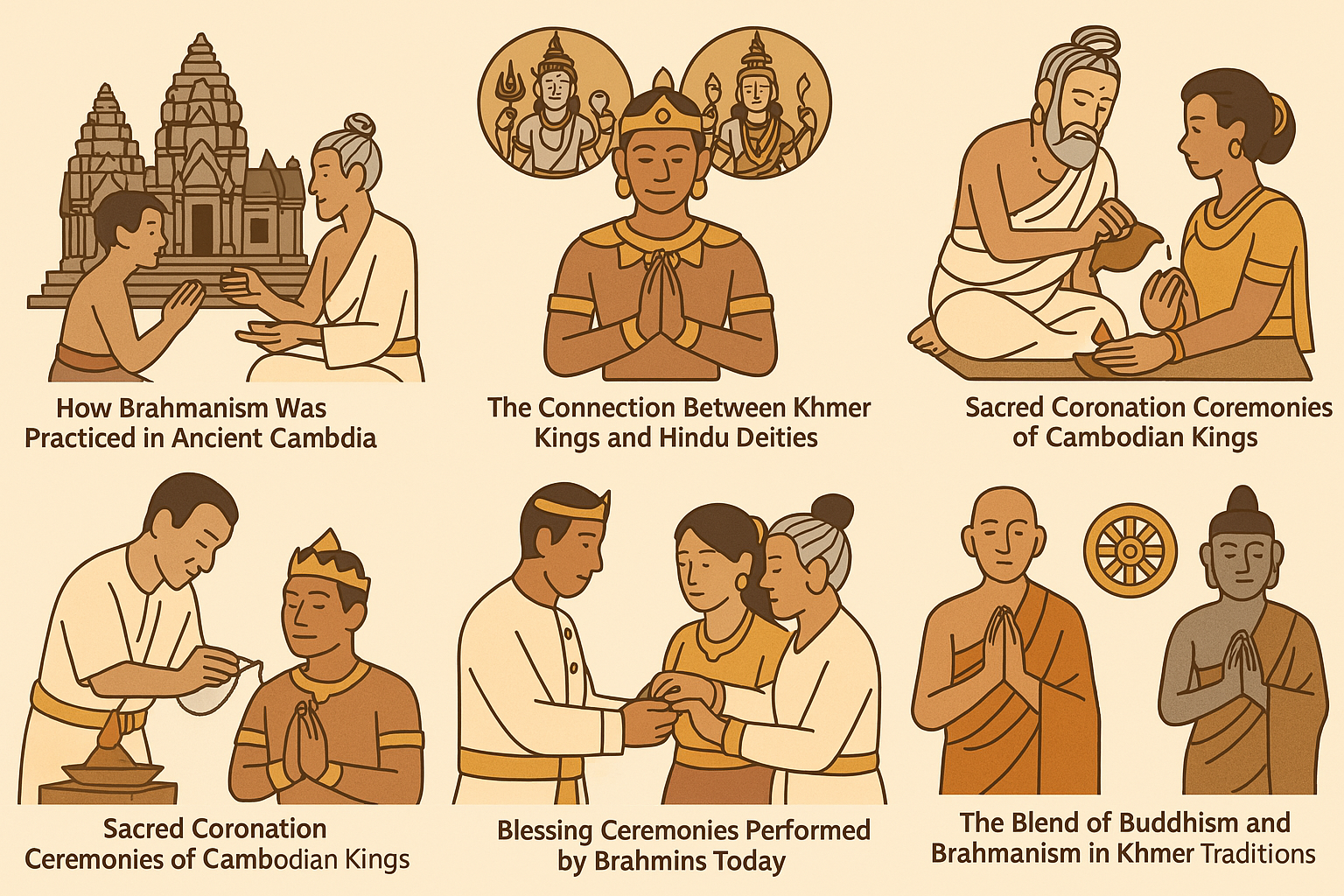Sacred Teachers, Spiritual Anchors, and Keepers of Khmer Culture
In Cambodia, Theravāda Buddhist monks—called bhikkhus in Pali—are far more than religious figures cloaked in saffron robes. They are spiritual guides, educators, counselors, and cultural pillars who maintain a powerful presence in everyday Cambodian life. From rural villages to urban centers, Buddhist monks influence everything from ritual practices to moral values, from politics to education, making them one of the most respected groups in Khmer society.
How Young Boys Become Buddhist Novices
Many Cambodian boys temporarily ordain as novices (Sāmaṇera), usually between the ages of 7 and 19. This tradition is not only a spiritual rite of passage but also a cultural and educational opportunity, especially for boys from poor families who may not have access to formal schooling.
The Ordination Process:
- Preparation: Boys are taught basic Buddhist teachings and rituals.
- Hair Shaving Ceremony: Shaving the head symbolizes renunciation of vanity and worldly attachments.
- Robe Offering Ceremony: Families and sponsors present the boy with saffron robes.
- Monastic Vows: The novice takes the Ten Precepts—basic moral guidelines distinct from the full monk’s 227 rules.
These novice periods can last days, months, or even years. Many boys return to lay life afterward, carrying the moral training, discipline, and education they received in the monastery.
The Daily Life of a Cambodian Monk
Monastic life in Cambodia is structured, minimalist, and devoted to spiritual discipline. A monk’s daily routine reflects the principles of mindfulness, non-attachment, and service.
Typical Daily Schedule:
- 4:00 AM – Wake and meditate
- 5:30 AM – Alms round (Tak Bat): Monks walk barefoot to receive food offerings from laypeople.
- 7:00 AM – Breakfast
- 8:00–11:00 AM – Study, teaching, chanting
- 11:30 AM – Last meal of the day
- Afternoon – Meditation, scripture study, community counseling
- Evening – Chanting, reflection, and rest
Monks are forbidden from eating after noon, handling money, or engaging in entertainment. Their daily life embodies detachment from materialism, and their presence serves as a living reminder of the Dhamma (Buddhist teachings).
The Monk’s Role in Funerals, Weddings, and Festivals
Monks are central to life’s major transitions and Khmer ceremonial culture.
Funerals:
Monks chant Pali verses to guide the deceased’s spirit toward a favorable rebirth. They offer blessings for grieving families and lead merit-making rituals like offering robes and food to the Sangha.
Weddings:
While monks do not conduct the wedding ceremony itself (as marriage is a worldly affair), they are often invited to bless the union beforehand through chanting and holy water sprinkling.
Festivals:
Monks are indispensable during Buddhist holidays like:
- Pchum Ben (honoring ancestors)
- Kathina (robe-offering season)
- Vesak (Buddha’s birth, enlightenment, and death)
They also lead processions, give sermons, and host meditation sessions during these observances. Monks act as a bridge between the spiritual and material world during all community events.
How Monks Serve as Spiritual Advisors in Communities
In rural and urban Cambodia alike, monks are revered as moral and spiritual authorities. People seek them out for:
- Personal guidance on family issues, health, or business decisions
- Blessings for new homes, babies, or vehicles
- Conflict resolution through Buddhist principles
- Teaching Dhamma and meditation to laypeople
Their monasteries, or wats, function as community centers, schools, orphanages, and disaster relief hubs. In essence, the monk is not just a religious figure but also a cultural caretaker and a counselor.
Monastic Hierarchy and Structure in Cambodian Buddhism
Cambodian monastic life is governed by a clear hierarchy:
- Sāmaṇera (Novices): Boys and young men in training.
- Bhikkhu (Ordained Monk): Full-fledged monk who observes all Vinaya rules.
- Achaan: A senior monk with teaching duties.
- Abbot (Chao Wat): Head of a monastery, often a highly respected community leader.
Beyond individual temples, Cambodia has two major Buddhist orders (nikāyas):
- Maha Nikāya – the larger, more traditional order.
- Dhammayuttika Nikāya – stricter in discipline, historically supported by royalty.
Each level of the hierarchy reflects spiritual seniority, education, and moral standing, but all monks are expected to follow the Vinaya (monastic code of conduct).
Monks in Politics: Past and Present
Historically, monks were politically influential in Cambodia. During the French colonial period and post-independence era, they supported nationalism, social reform, and resistance movements. Some notable cases include:
- Venerable Huot Tat, who was executed by the Khmer Rouge for his influence.
- Monks’ participation in 1990s protests advocating for democracy and human rights.
In modern Cambodia, monks are officially discouraged from engaging in politics, but many continue to voice concerns on corruption, deforestation, poverty, and education. Some progressive monks use social media to raise awareness about ethical issues, drawing both praise and government scrutiny.
The Challenges of Modernity for Cambodia’s Buddhist Monks
As Cambodia rapidly modernizes, monks face growing pressures:
1. Materialism vs. Simplicity
Urbanization and consumer culture challenge the monk’s vows of detachment. The integrity of monastic life is sometimes questioned when monks use smartphones or travel by car.
2. Education and Literacy
Many rural monks lack formal education beyond basic Pali texts, limiting their ability to engage with modern issues or connect with educated youth.
3. Youth Engagement
Fewer boys are choosing to ordain, even temporarily. Meanwhile, social media and entertainment are reducing public interest in traditional Buddhist teachings.
4. Political Pressure
Outspoken monks risk intimidation or defrocking if their activism is perceived as opposing the ruling powers.
Despite these challenges, monks continue to adapt—through teaching environmental ethics, participating in humanitarian aid, and even incorporating digital tools to spread the Dhamma.
Conclusion: Monks as the Moral Backbone of Cambodia
Cambodian monks are more than religious practitioners—they are educators, guardians of tradition, spiritual advisors, and social voices. Their daily lives reflect timeless values of compassion, mindfulness, and humility, even as they navigate the complexities of modern society.
In a world that’s changing rapidly, Cambodian monks remain deeply rooted in ancient wisdom, reminding the nation of its spiritual heritage while quietly guiding its future.





